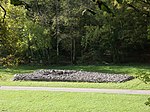Portal:Wales/Selected article/2
Parc Cwm long cairn (Welsh: carn hir Parc Cwm), also commonly known as Parc le Breos burial chamber (siambr gladdu Parc le Breos), is a partly restored Neolithic chambered tomb, identified in 1937 as a Severn-Cotswold type of chambered long barrow. The megalithic burial chamber, or cromlech, was built around 5850 years before present (BP), during the early Neolithic. It is about 7.5 miles (12 km) WSW of Swansea, at Parc le Breos on the Gower Peninsula. Parc Cwm long cairn is maintained by Cadw.
A trapezoidal cairn of rubble – the upper part of the cromlech and its earth covering now removed – about 72 feet (22 m) long by 43 feet (13 m) (at its widest), is revetted by a low dry-stone wall. A bell-shaped, south-facing forecourt, formed by the wall, leads to a central passageway lined with limestone slabs set on end. Human remains had been placed in the two pairs of stone chambers that lead from the passageway. Corpses may have been placed in nearby caves until they decomposed, when the bones were moved to the tomb.

